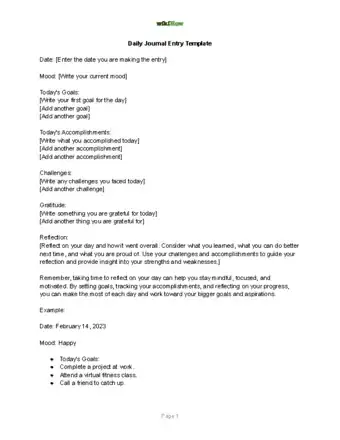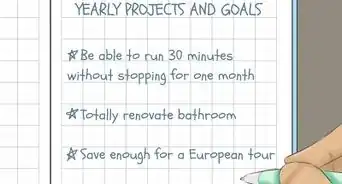This article was co-authored by Nicolette Tura, MA. Nicolette Tura is an Authentic Living Expert who operated her own wellness business for more than ten years in the San Francisco Bay Area. Nicolette is a 500-hour Registered Yoga Teacher with a Psychology & Mindfulness Major, a National Academy of Sports Medicine (NASM) certified Corrective Exercise Specialist, and is an expert in authentic living. She holds a BA in Sociology from the University of California, Berkeley and got her master's degree in Sociology from SJSU. She constantly draws from her own wounds and challenges; with her training in the healing arts and sociology, she offers potent content, powerful meditations, and game-changing seminars on inspiring elevation on a personal and corporate level.
wikiHow marks an article as reader-approved once it receives enough positive feedback. This article has 26 testimonials from our readers, earning it our reader-approved status.
This article has been viewed 425,824 times.
In order to start a journal, you'll need a notebook, a writing tool, and a commitment to yourself. The first move is to write your first entry. Then, you can think about keeping up a regular journal! Use the journal as a way to explore your innermost thoughts and feelings – the things that you cannot tell anyone else.
Steps
Journal Entry Template
Preparing a Journal
-
1Find a notebook to write in. The book can be simple or ornate. If you're happy with a simple journal, then just buy a basic college-ruled notebook. If you want something more serious, look for a nice leather-bound journal – perhaps even one with a lock and key!
- Choose between a lined or an unlined notebook. A lined notebook can be better for writing, while an unlined notebook might facilitate art and drawing. Think about how you prefer to set down your ideas, and choose a notebook that inspires you to fill it.
- If you plan to carry your notebook with you (in your purse, pack, or pocket,) make sure to use a notebook that is small enough to conveniently pack around.
-
2Decorate the notebook. Make the journal your own by infusing it with a unique style. Personalize the covers with words, art, stickers, and colors. Take clippings from your favorite magazines, and post them on the inside or outside of the journal. If decoration isn't your thing, then feel free to leave the journal plain!
- Consider numbering the pages. You can do this all at once, or you can gradually number the pages as you fill them. This can be a great way to keep track of what you write.
Advertisement -
3Keep a digital journal. This can be a secure and easy-access means of preserving your thoughts. Log your entries in Microsoft Word or another basic word processor. Save the entries in a special folder, or compile them into a single, canonical document.
- Consider using a system that you can access with a password through a cloud or over the Internet. This way, you can open and edit your journal from any computer or device! Try WordPress, or even using your email client.
- For all the benefits of digital journal-keeping, you may miss the charm of a physical journal. Try it out, if you're curious. Consider keeping some notes in a physical notebook, and others in a drive on your computer.
Starting to Journal
-
1Write the first entry. The most important step of starting a journal is actually setting down the first entry. The notebook, the decoration, and the security are all just ways of making the journal feel like a safe space for you to write. Think about the sort of journal that you keep. Then, write what's on your mind.[1]
- Write about what happened today. Include where you went, what you did, and who you spoke to.
- Write about what you felt today. Pour your joys, your frustrations, and your goals into the journal. Use the act of writing as a way to explore your feelings. Consider keeping a dream journal.
- Keep a learning log. Write about what you learned today. Use the journal as a way to explore and connect your thoughts.[2]
- Turn your experiences into art. Use the journal to write stories or poetry, to make sketches, and to plan out projects. Feel free to mix this in with your other entries.
-
2Date your entry. If you are going to keep a regular journal, then it's good to establish some way of tracking when you wrote what. Write the full date, or whatever you'll need to jog your memory: e.g. 2/4/2016 or Feb. 4, 2016. For a slightly more involved record, write the time of day (morning, afternoon, night), your mood, and/or your location. Log the date at the top of the page or the top of each entry.
-
3Get into the flow of writing. Try not to think too critically about what you're setting down. Let go of your doubts, and write your truth. The beauty of a journal is that you can tell the story that you don't usually tell people: the deep thoughts and feelings that lie behind your day-to-day decisions. Take the opportunity to explore yourself.[3]
- Imagine that you are talking to someone. Whether you are talking to a close friend or pouring your thoughts into a journal: you are putting them out into the world, and thus making them real. It can be hard to really get a grasp on what you're thinking until you make your thoughts real.
- Use journaling as a healing tool.[4] If there is something haunting you or bothering you, try to write about that thing and understand why exactly it has stuck on your mind.[5]
-
4Think before you write. If you're having trouble finding your flow, try taking a few minutes to quietly reflect on what you're feeling. The act of writing can help you tease out these feelings. However, it can be hard to write until you have a clear idea of where to begin.
-
5Time yourself. Try setting aside a discrete amount of time to write in your journal. Set a timer for 5 to 15 minutes, and then let yourself go. The "deadline" of the ticking clock may help motivate you to get writing. Don't worry about making it perfect! Simply write down everything that's on your mind.[6]
- If the timer goes off and you haven't finished journaling, then feel free to keep going. The point of the timer is not to limit you, but rather to spur you.
- This can be a great way to fit your journaling practice into the busy flow of everyday life. If you have trouble finding the time to write in your journal, then you may need to schedule it in.[7]
Keeping a Journal
-
1Carry the book with you. This way, you can record your thoughts whenever they strike. Keep the journal in your purse, your pack, or your back pocket. When you have a free moment, try pulling out your journal instead of your cell phone. You may find that this helps you stay grounded on a day-to-day basis.
- Carrying the journal around has the added bonus of keeping your words private. If you always keep your journal close, then it's less likely to fall into the wrong hands.
-
2Keep your journal private. If you've poured your deep, personal thoughts into this journal, then you probably don't want anyone else to read it. Hide the journal somewhere that no one else will find it. Great hiding places include:
- Behind the books on your bookshelf.
- Under your mattress or pillow
- In the drawer of your bedside table
- Behind a picture frame
-
3Keep the cover discrete. Do not label the journal things like "Private!" or "Do NOT read!" This will make people curious and want to read it even more. It would be best to leave the cover blank or to disguise it as something more boring, such as "Homework" or "Shopping Lists."
- If you do want to label it "My Journal" or "Private!" be sure to hide it well.
-
4Write regularly. Make a practice of keeping a journal. Reap the various mental-health benefits of staying in touch with your emotions on a day-to-day basis.[8] Each time you write in your journal, remind yourself to be honest and tell the whole truth.
- Try scheduling journal time into your day-to-day flow. Some people journal before bed, or immediately after they wake. Some people journal during their daily commute or during their lunch hour. Find a time that works for you.
-
5
Community Q&A
-
QuestionWhat happens if my friends keep asking me questions about where my journal is?
 Kira MeCommunity AnswerIf you want to keep the journal for yourself, don't show it to them no matter what. First thing you can do is to avoid the topic and make them forget about the journal. When this doesn't work and they keep asking, confront them openly. Stand up for yourself and make it clear that it is your personal thing, and they have no right to want it from you. If you see that the situation requires it, tell them something general about the journal (like "I write about my day to relieve stress throught it"). Maybe they would become less curious; however, be kind, patient and stand up for yourself
Kira MeCommunity AnswerIf you want to keep the journal for yourself, don't show it to them no matter what. First thing you can do is to avoid the topic and make them forget about the journal. When this doesn't work and they keep asking, confront them openly. Stand up for yourself and make it clear that it is your personal thing, and they have no right to want it from you. If you see that the situation requires it, tell them something general about the journal (like "I write about my day to relieve stress throught it"). Maybe they would become less curious; however, be kind, patient and stand up for yourself -
QuestionHow can I make my journal look the best?
 Community AnswerMake it your own! Add stickers, pictures of your favorite bands/movies, etc. Make it organized and unique.
Community AnswerMake it your own! Add stickers, pictures of your favorite bands/movies, etc. Make it organized and unique. -
QuestionWhat should I write about in my journal?
 Community AnswerWrite about your hopes and dreams, your fears or your day-to-day experiences.
Community AnswerWrite about your hopes and dreams, your fears or your day-to-day experiences.
Warnings
- Make sure to keep your journal safe if you don't want anyone to read it! Hide it where no one will find it: family, friends, acquaintances, or enemies.⧼thumbs_response⧽
References
- ↑ https://www.theguardian.com/lifeandstyle/2014/mar/22/how-to-start-journal-writing-drawing
- ↑ https://www.niu.edu/citl/resources/guides/instructional-guide/reflective-journals-and-learning-logs.shtml
- ↑ http://psychcentral.com/lib/the-health-benefits-of-journaling/
- ↑ https://www.urmc.rochester.edu/encyclopedia/content.aspx?ContentID=4552&ContentTypeID=1
- ↑ Nicolette Tura, MA. Authentic Living Expert. Expert Interview. 23 January 2020.
- ↑ https://www.theguardian.com/lifeandstyle/2014/mar/22/how-to-start-journal-writing-drawing
- ↑ http://www.artofmanliness.com/2009/06/07/30-days-to-a-better-man-day-8-start-a-journal/
- ↑ https://www.urmc.rochester.edu/encyclopedia/content.aspx?ContentID=4552&ContentTypeID=1
- ↑ Nicolette Tura, MA. Authentic Living Expert. Expert Interview. 23 January 2020.
About This Article
To start a journal, first find an empty notebook to write in. You can decorate the notebook with stickers, drawings, magazine clippings, or anything else you want to use to personalize it. Then, open to the first page and start the first entry by writing today’s date at the top. Journal about what happened to you today, how you’ve been feeling, what your goals are, what you dreamed about last night, or anything else that’s on your mind. Journaling can be a helpful way to reflect on your feelings, keep track of important information, or organize your goals and accomplishments. Try to set aside 10-15 minutes per day to write in your journal. Whenever you start a new entry, open to a new page and write the day’s date at the top. Remember to keep your journal somewhere safe if you don’t want other people to read it, like a drawer in your room or underneath your pillow. To learn how to pick a journal that’s right for you, keep reading!











































































